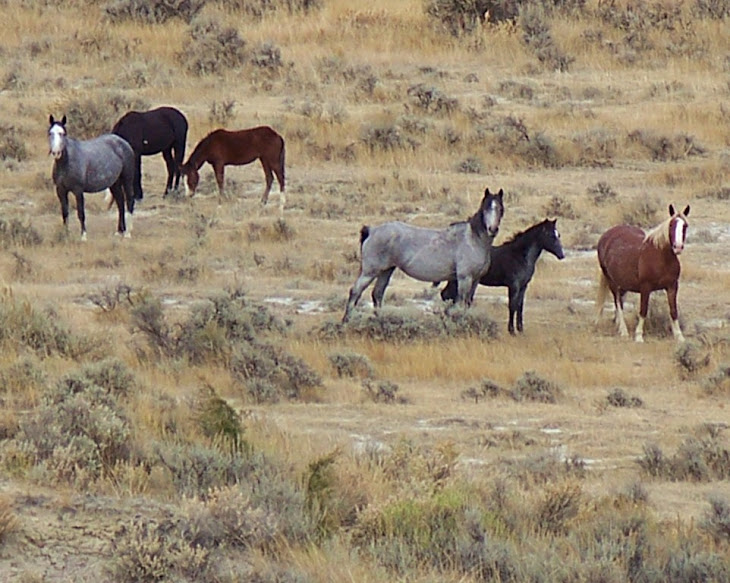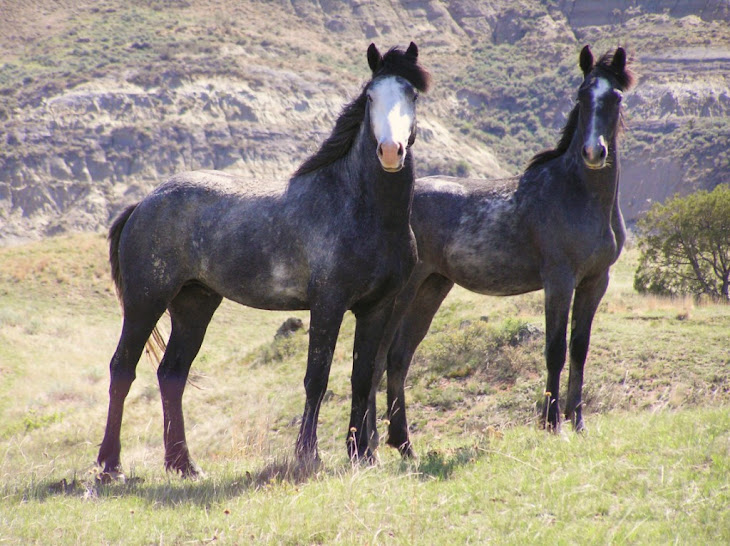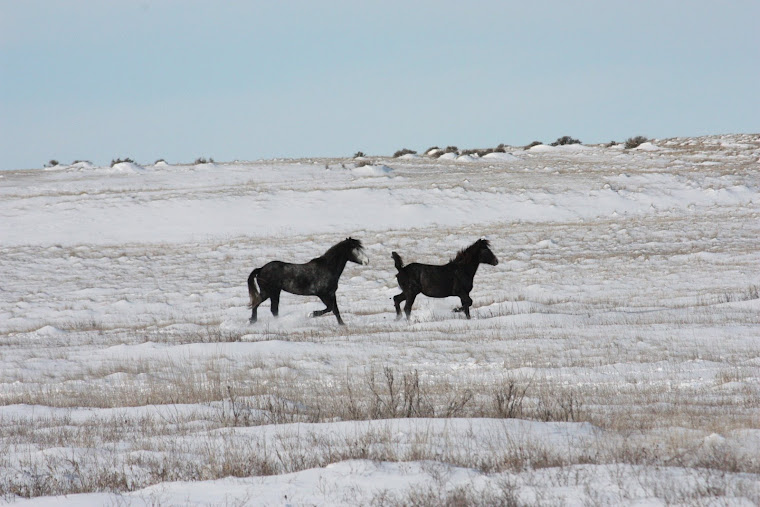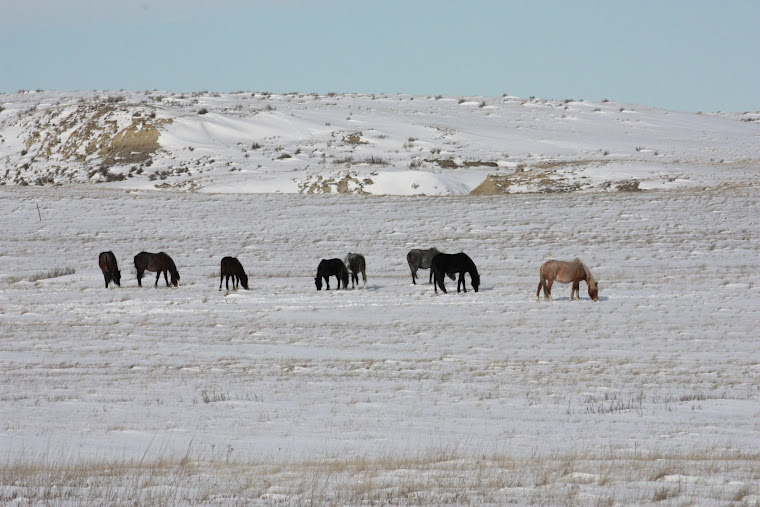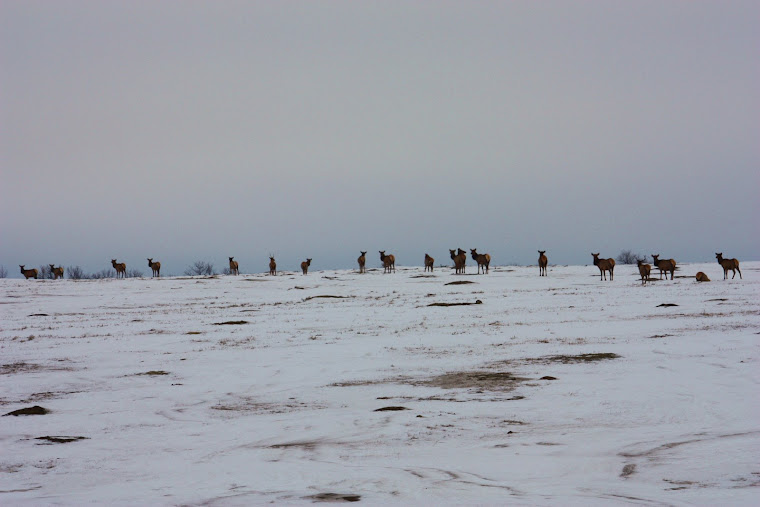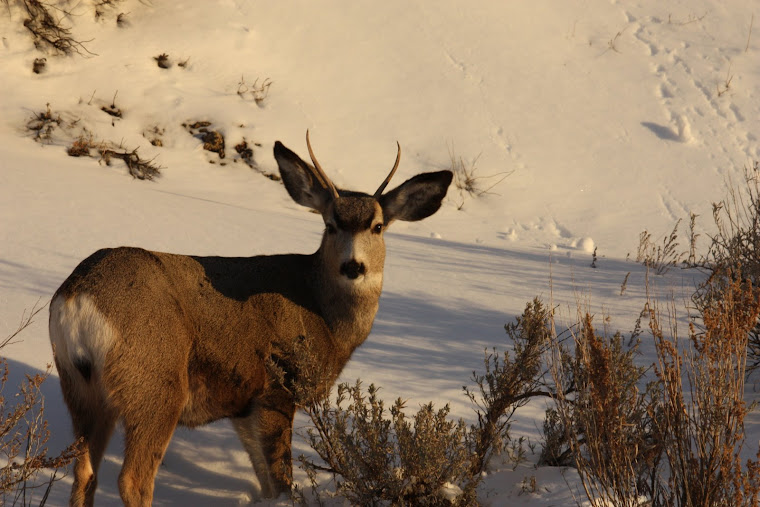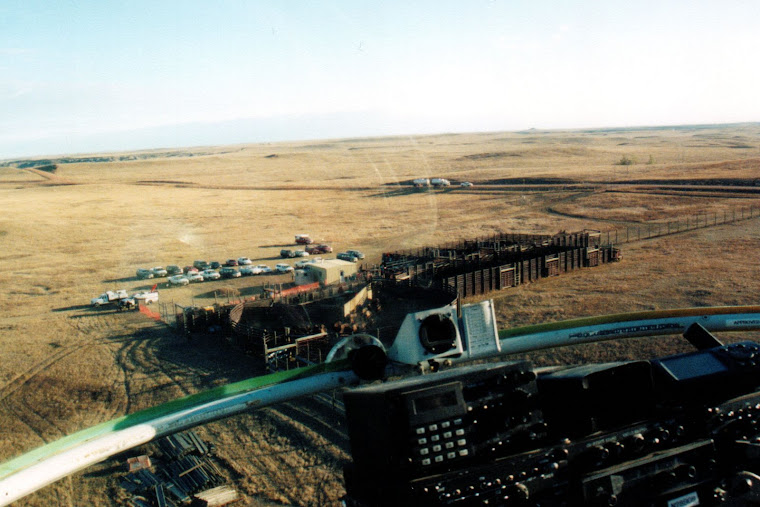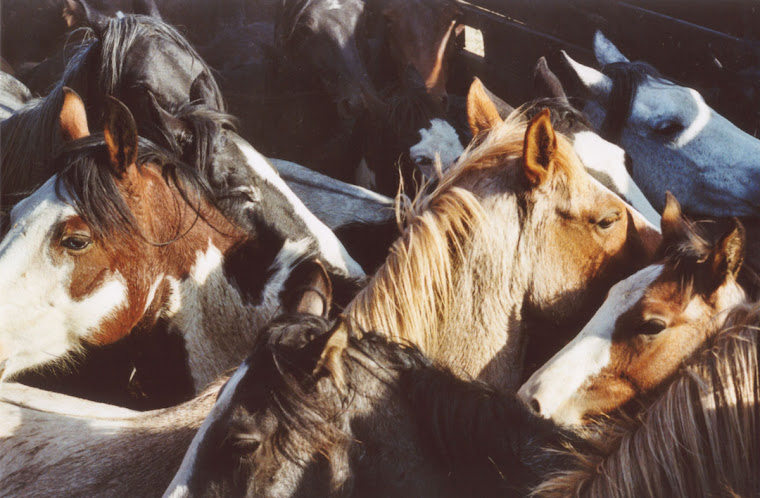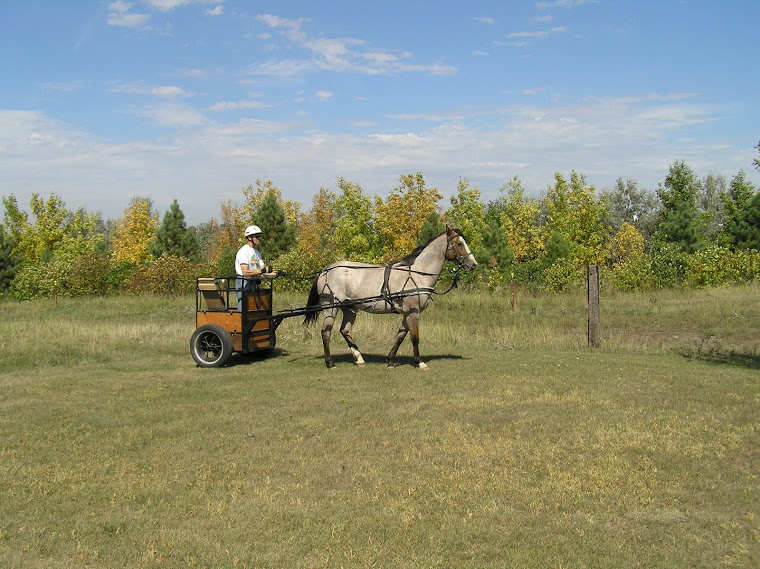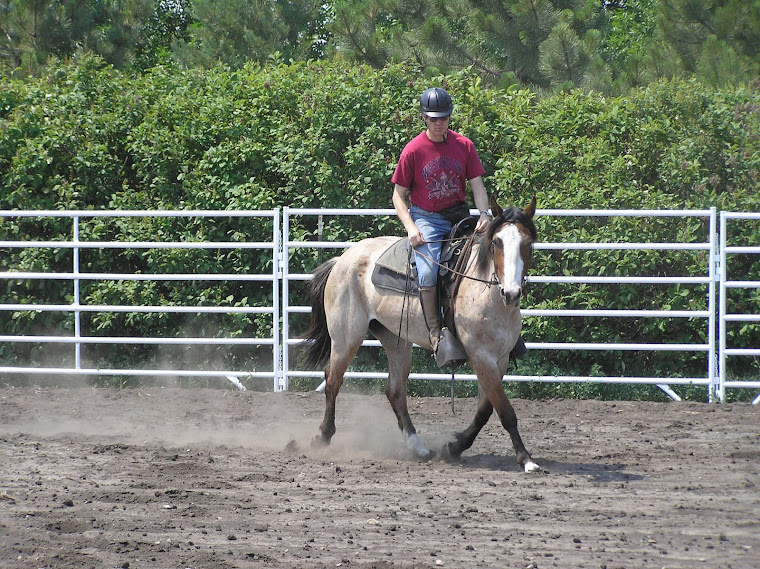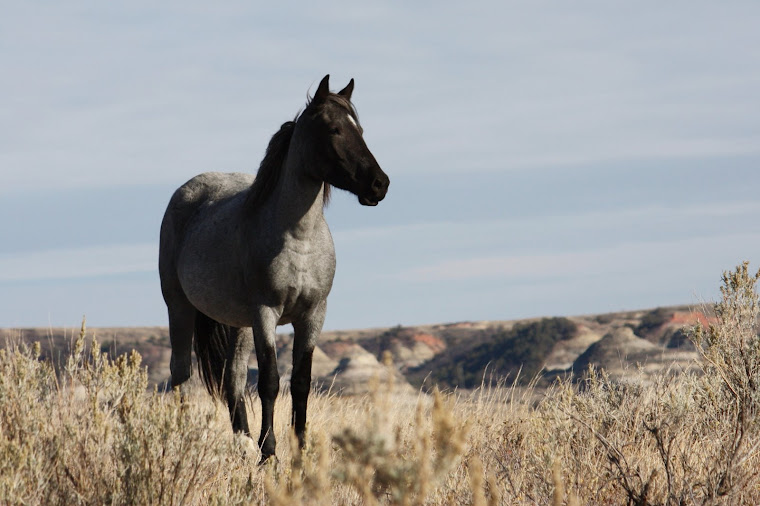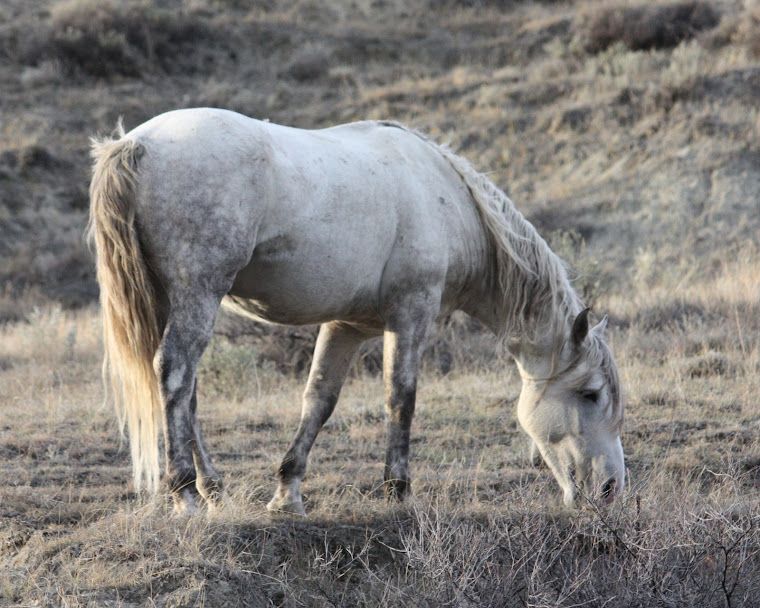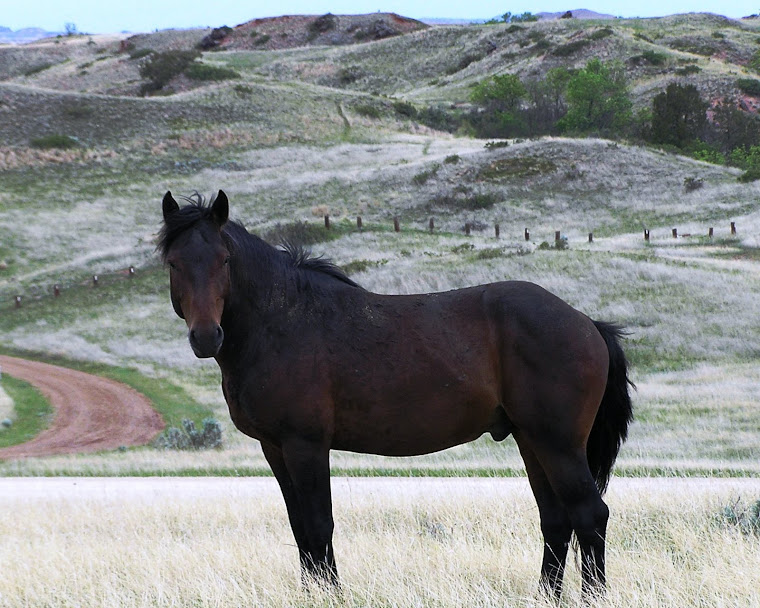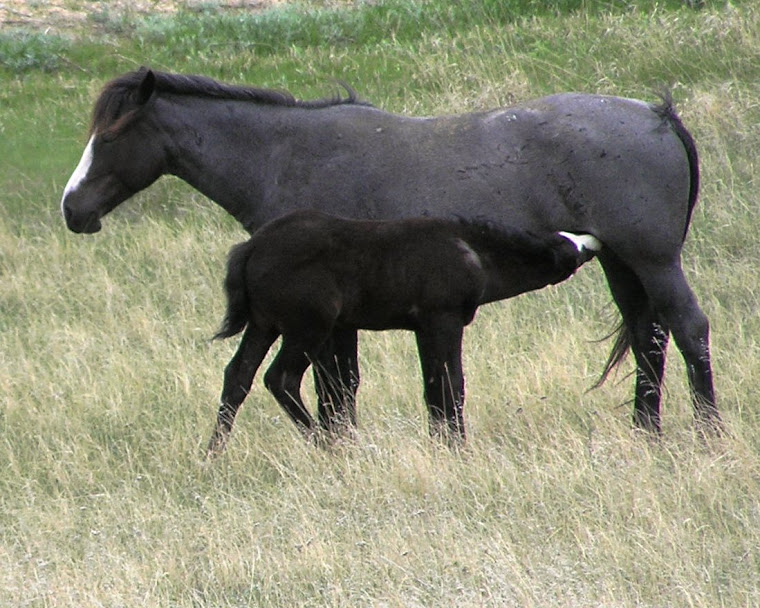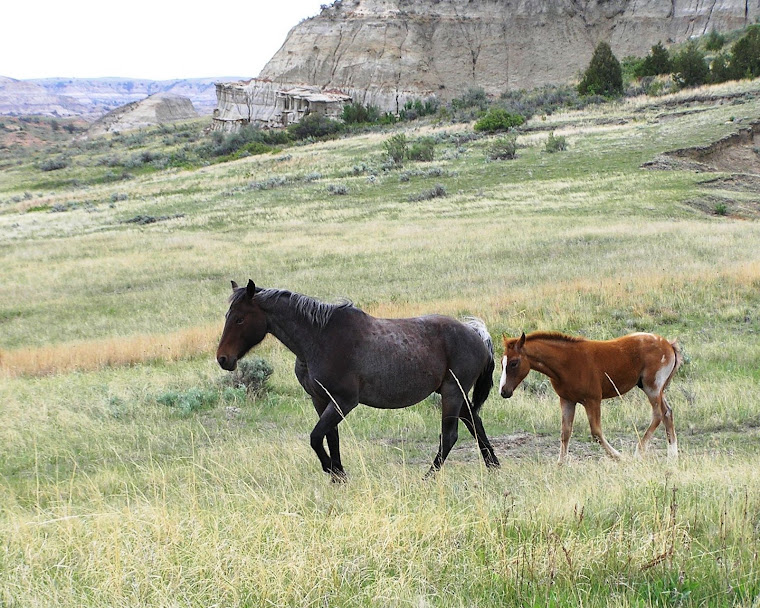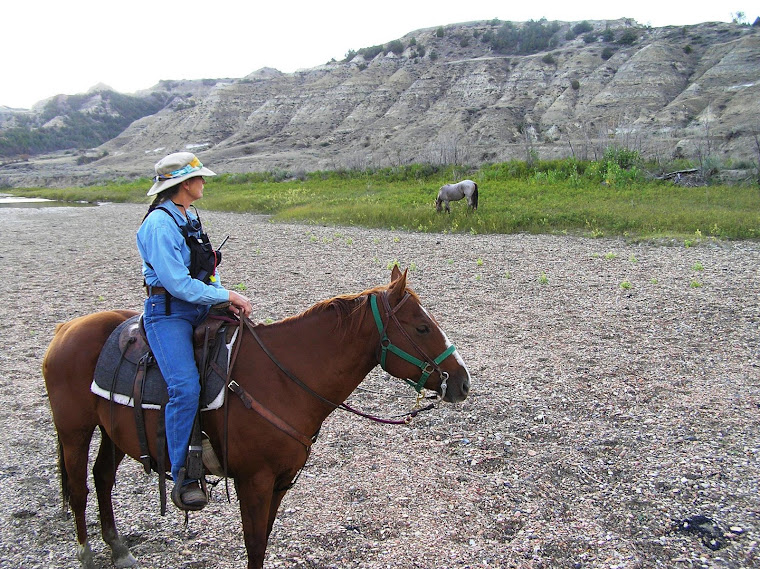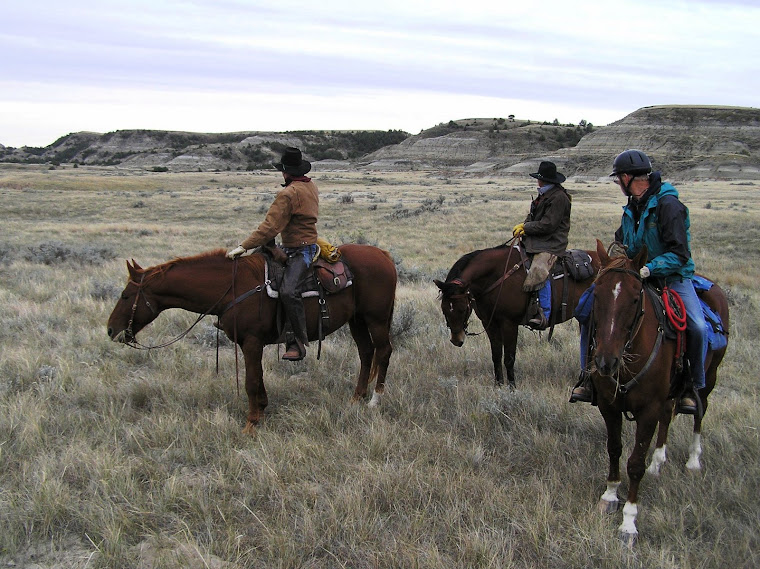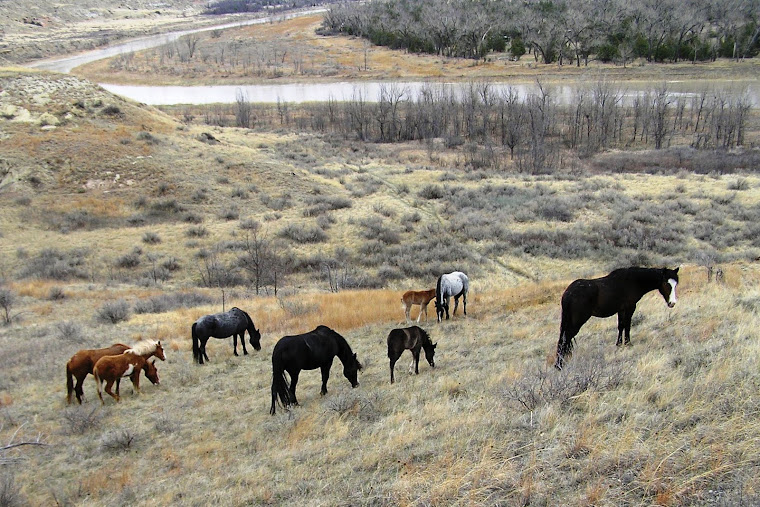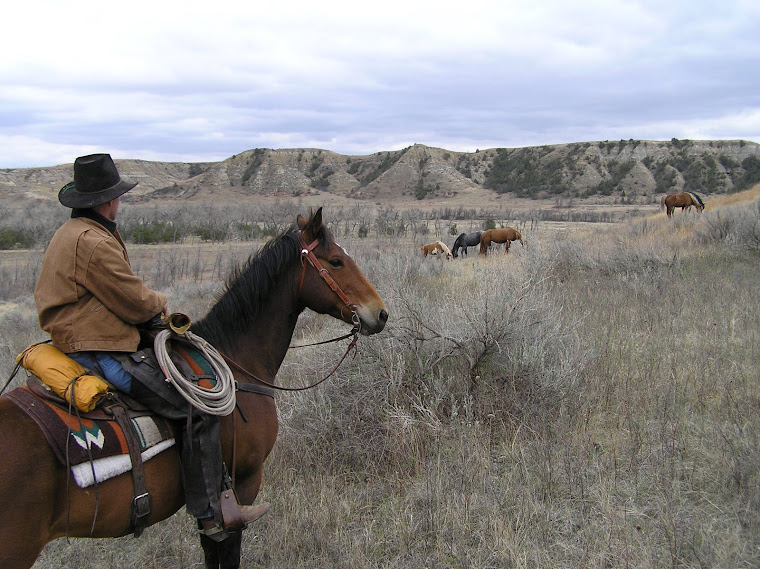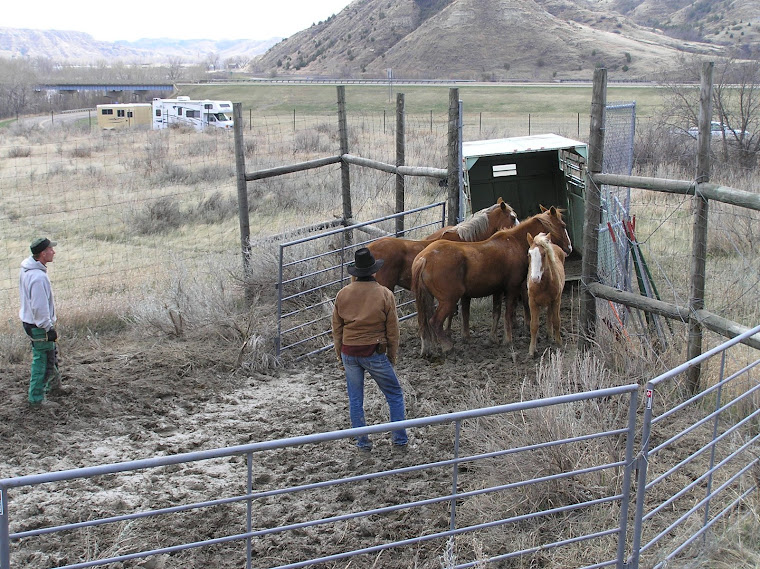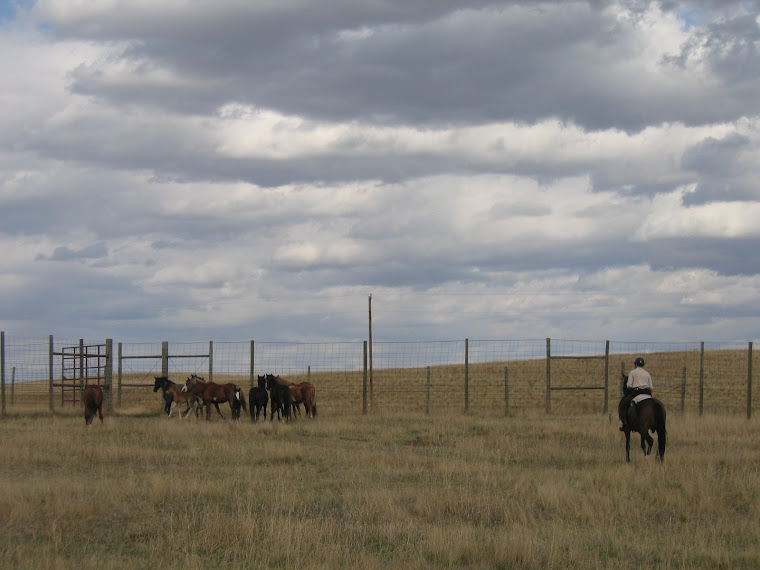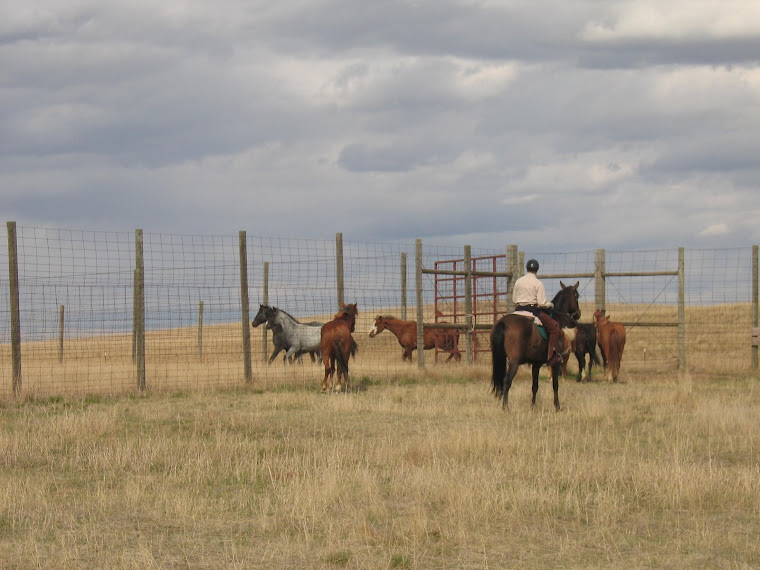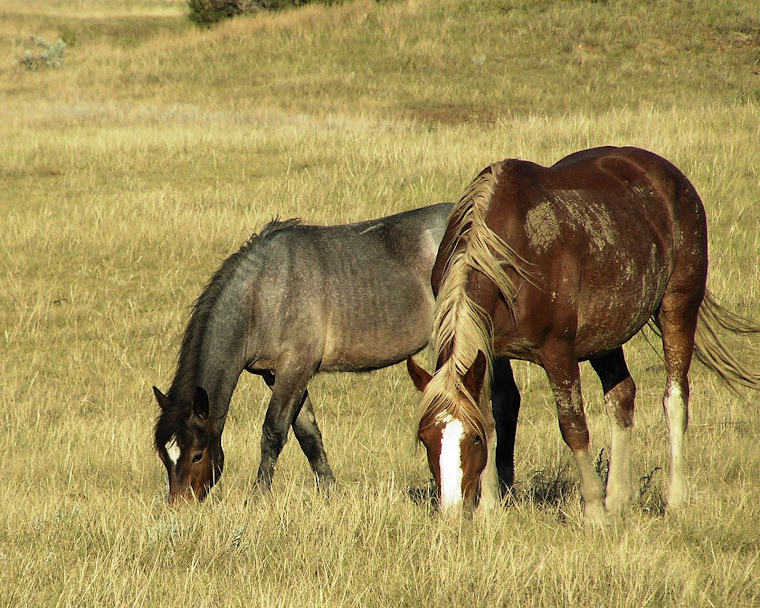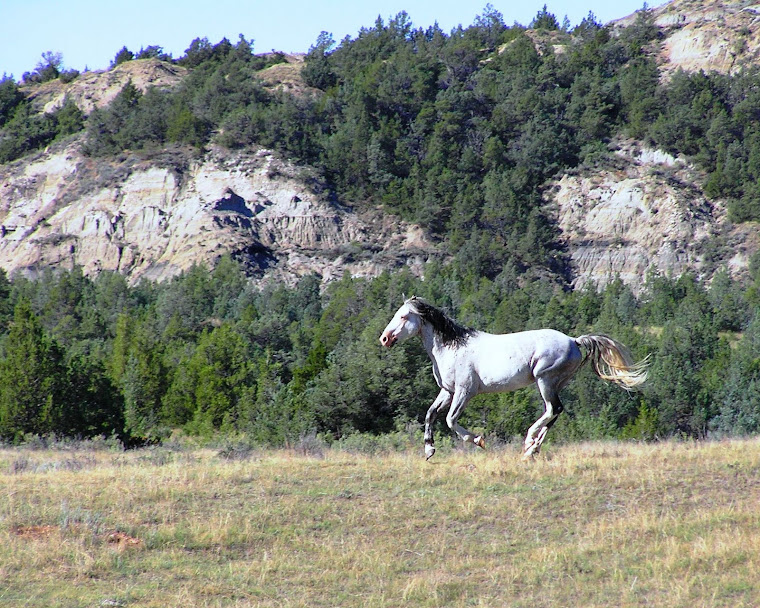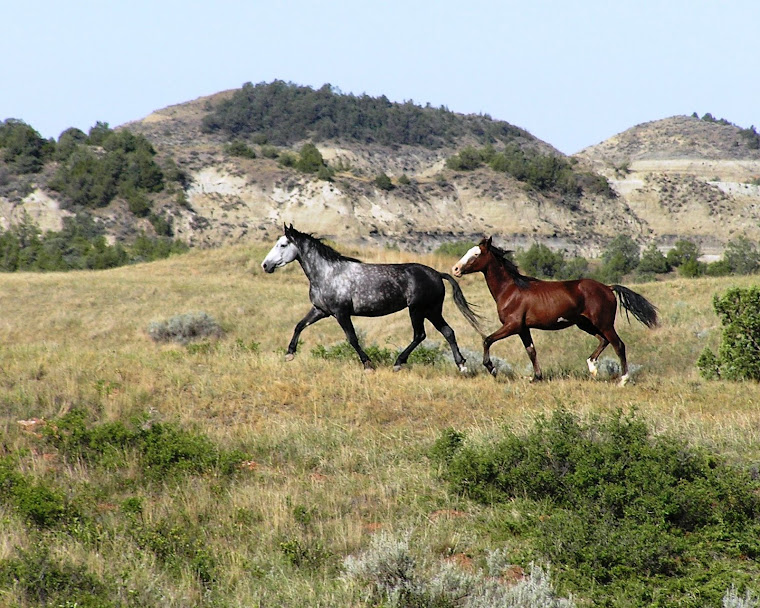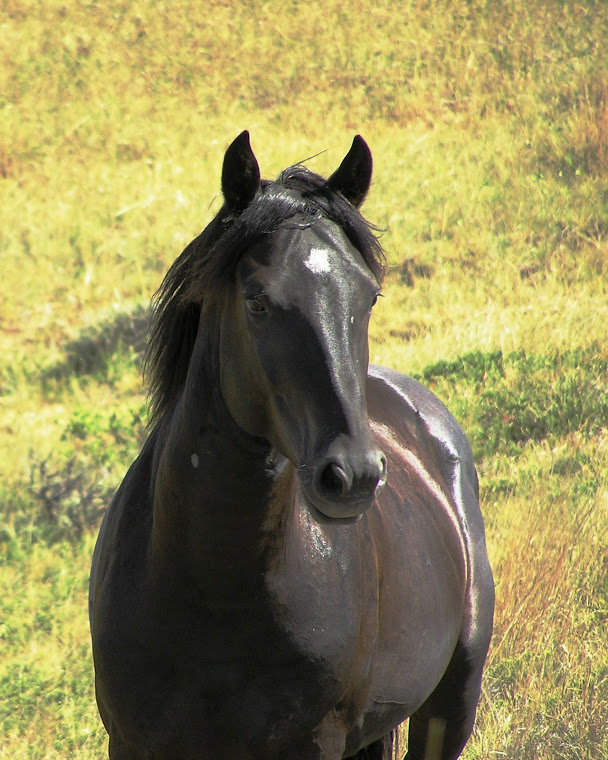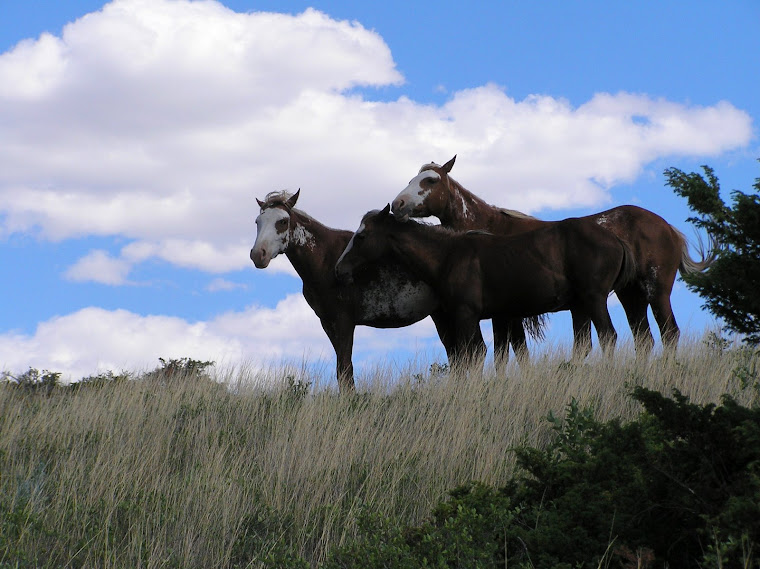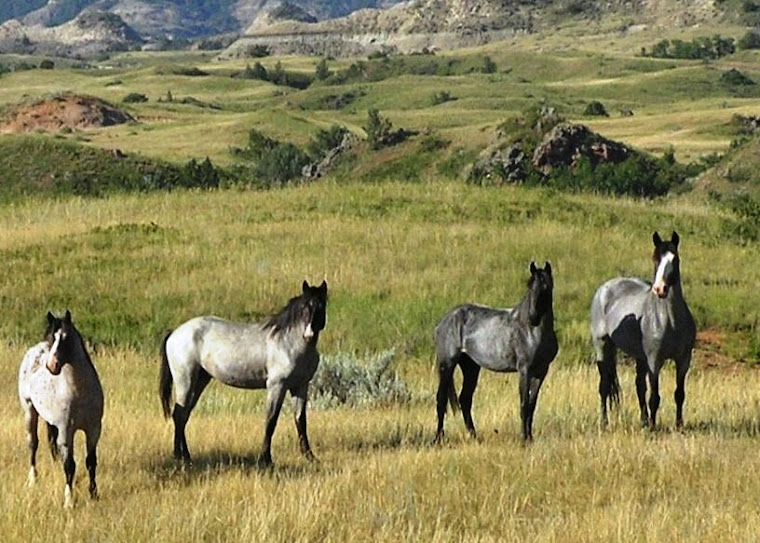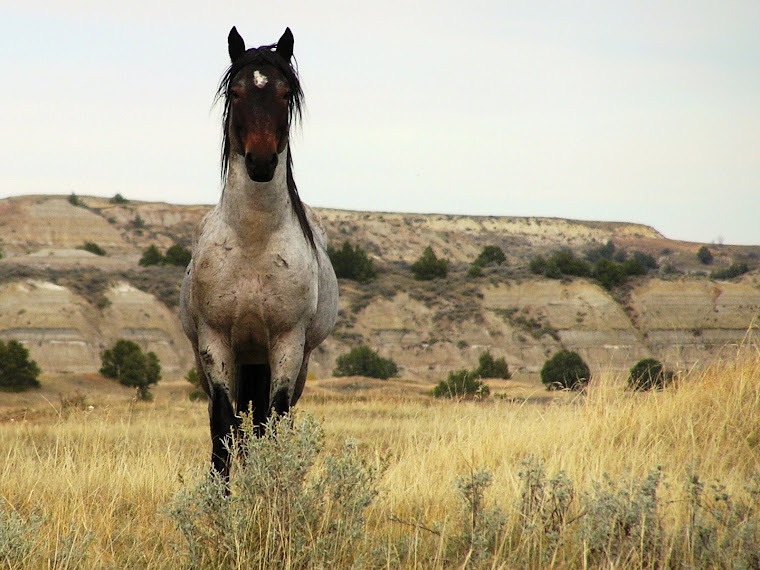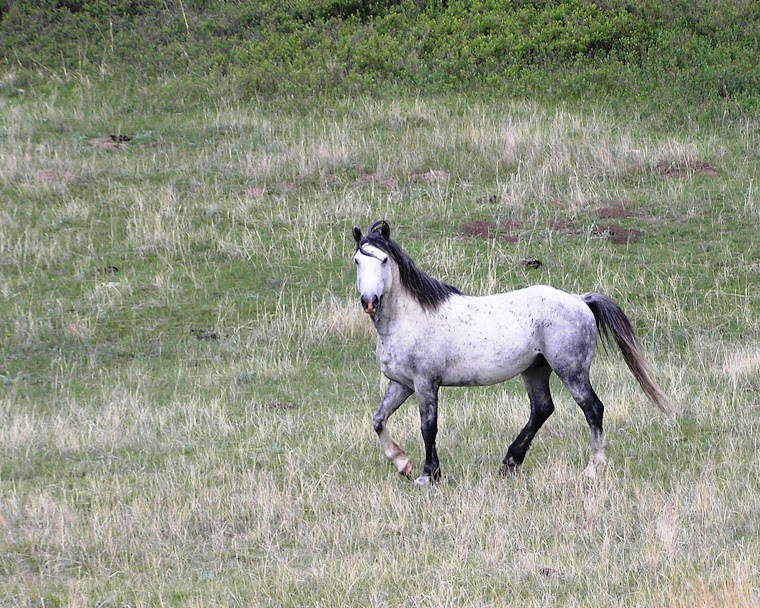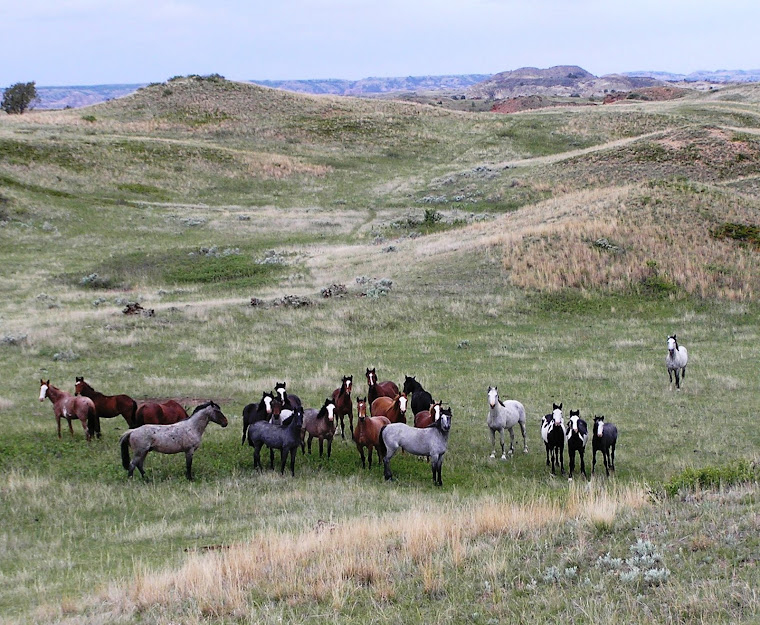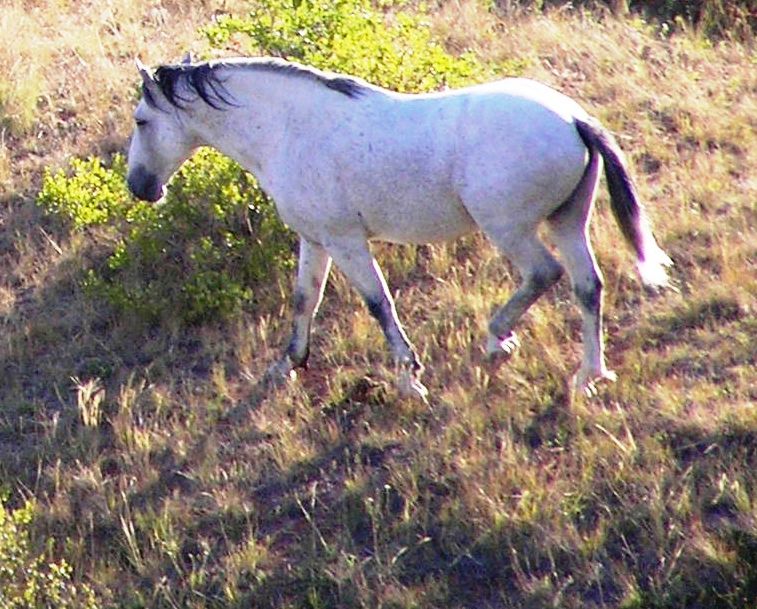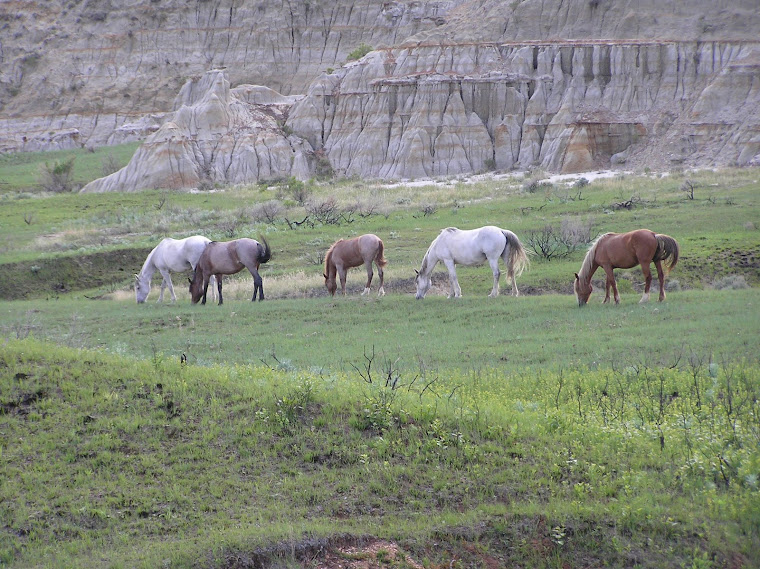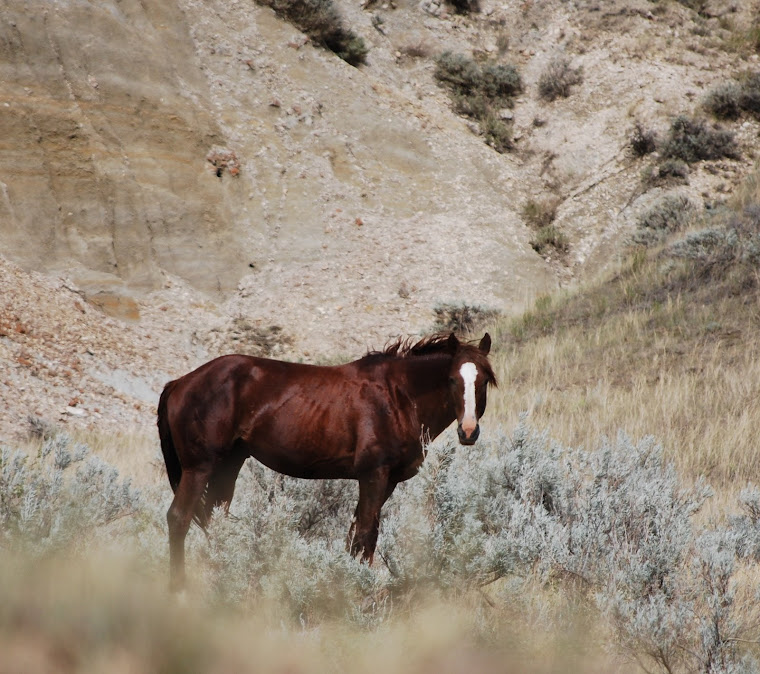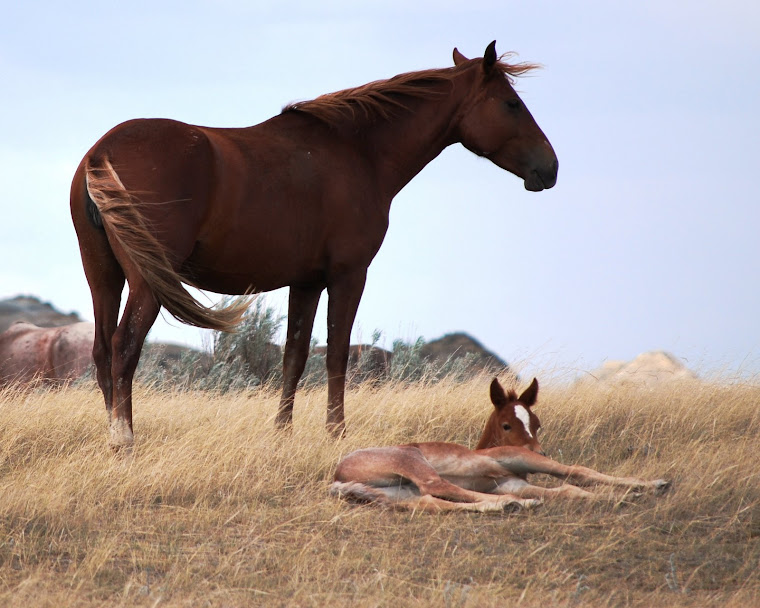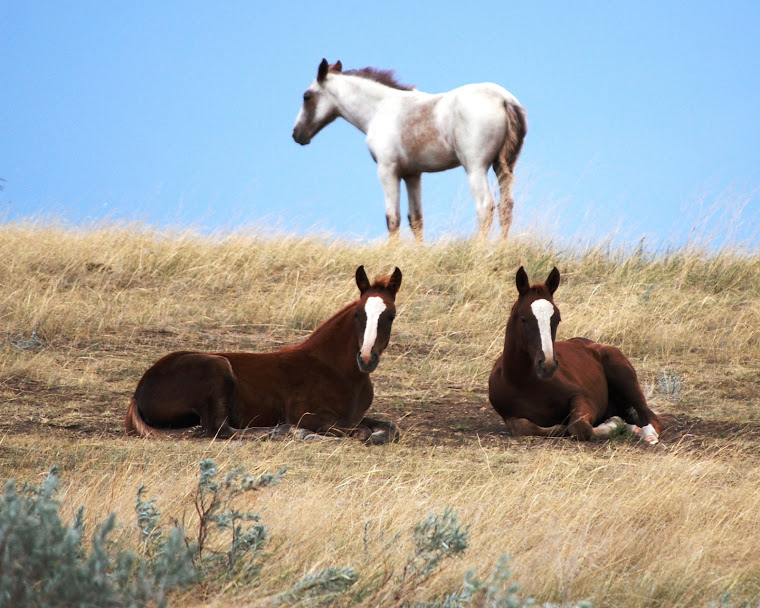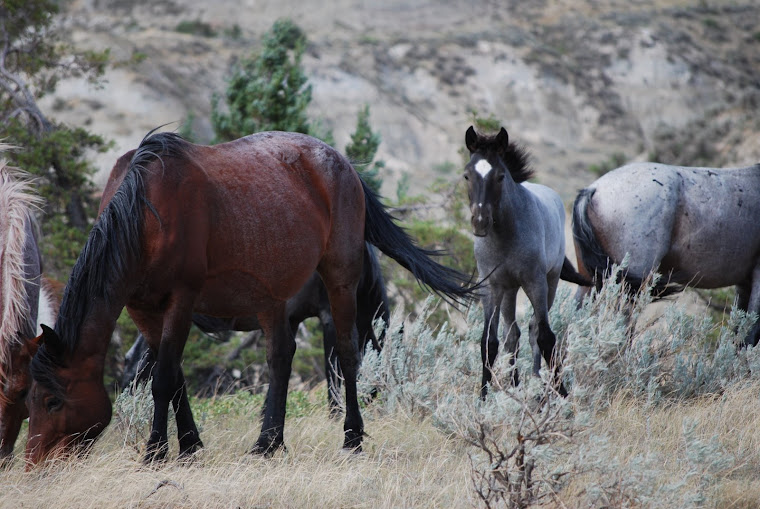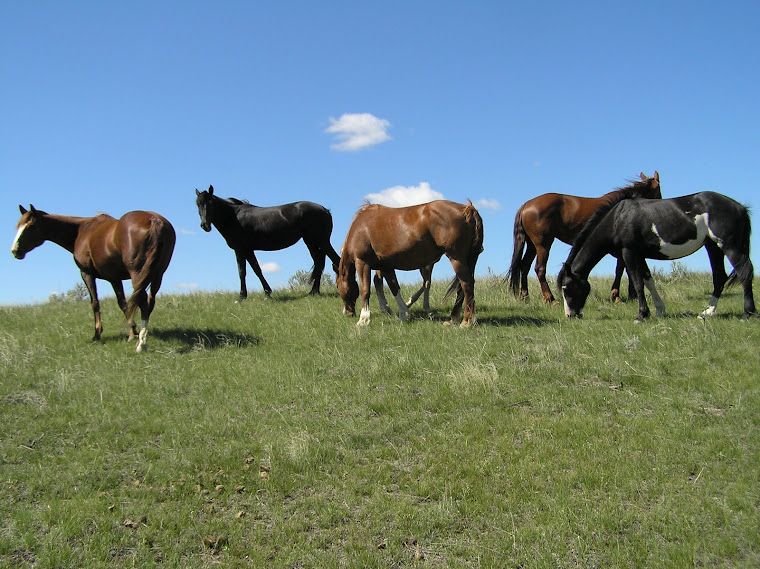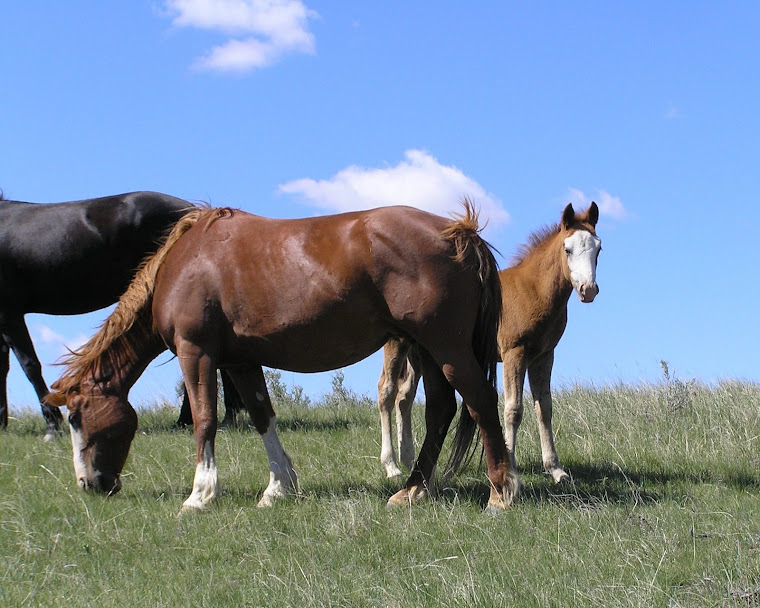From L to R are Bonnie and Sugar, Dan and Bashful, Whit and Teddy, Kristin and Baldy, Henry and Fire, Marylu and Hawk, Mya and Hail, and Bob and Crow. These horses were all born in the park.
The 2nd Annual Reunion Ride will be based out of Sully Creek State Park just south of Medora, ND, September 5-7. Come join us for trail rides in the park and other activities. You don't need to be riding a North Dakota Badlands Horse, you don't even need a horse. Just come and meet others who love the horses from Theodore Roosevelt National Park. Go to the Facebook page: North Dakota Badlands Horse for more information. Be sure to sign up for the event on that page.
Thursday, July 31, 2014
Sunday, July 27, 2014
THE GREAT ESCAPE
 |
| Tracking in the snow |
The Sieben Four Adventure
By Marylu Weber
At one mile
above sea-level, winter comes early to the Sieben Live Stock Company ranch
nestled in the foothills of the Big Belt Mountains of Montana. The four wild young stallions that had been
purchased from Theodore Roosevelt National Park had been gelded and kept
together in a large corral separated from the ranch headquarters so they could adjust
to ranch life gradually. They had plenty
to eat and drink, but something in their hearts must have been drawing them
back to the wild. One day in early
winter while having lunch at Cooper Hibbard’s house, Iain Davis saw that Sage,
Hawthorne, and Peace Pipe were on the wrong side of the fence around their corral. Tomahawk was still inside but running back
and forth trying to figure out how the others had gained freedom. Iain watched as Tomahawk too jumped the
narrow space between the wooden gate and the gatepost and all four galloped up
the hill behind the corrals. When a couple
of them dropped their heads to graze Iain hoped they would stay on the sunny
slope about ¾ of a mile from the corral complex. With any luck he could somehow
lure them back into the corrals, but the young horses had other ideas and within
the hour disappeared over a high ridge into what was wild, rugged breaks filled
with all sorts of wildlife, including bears and mountain lions.
Iain took
two bales of good hay up the mountain to entice the horses back or maybe even
catch them there. Hawthorne, always the
tamer of the four, came with the others behind him. Iain was able to get within 100 yards of them,
but it was too much pressure for the wilder horses and they all ran farther
into the rough country. As more snow
came Iain was able to track the horses but never get close to them. Several times he saw the tracks of mountain
lions following the horses. Fascinated
with the mountain lion tracks and how the dust from the barren areas the cat
had walked on would drop off onto the snow tracks, Iain took his phone out and
took a few pictures of the large tracks.
As he crouched there in the snow, intrigued with the size of the tracks
and the dust encircling each indentation from the cat’s pads, he noticed that
the wind was quickly blowing the dust away.
The cat must have been in that very spot only minutes earlier. Maybe it wasn't such a good idea to be
crouching in the snow so soon after the cat had passed that way; maybe he was
being watched at that very moment. After
all a pocket knife wasn't much of a weapon against a mountain lion. With the hair standing up on the back of his
neck and being much more aware of possible hiding spots for the big cats, Iain hiked
back out to the safety of the ranch, deciding the wild horses would have to
fend for themselves or come back to the safety of the corrals on their own.
It was
almost three months since the horses had run away to freedom. Efforts to bring them back were scrapped
because of the weather and the difficulty in traversing the back country in
winter. Would the ranchers ever see
those four ungrateful equines again?
They could travel for 100s of miles if they wanted to. Would they starve or become dinner for the
mountain lions? It was anyone’s guess,
but toward spring some hunters reported seeing horses not too far from the
corral complex so this time Iain baited his corral with hay, a mare in heat,
and later another gelding. The
adventurous boys seemed to long for the company of the mare and her companion
and gradually came back to the corral.
Seeing that they were hanging around by the corrals Iain was able to
sneak in, open the corral gate, run down the fence line, and hide so that he
could close the gate again if he was lucky enough to have them go in. One by one the wary young horses entered the
corral and went to eating the delicious hay.
The adventure was over and, though a little thin, they had all survived
winter blizzards, pawing through drifts for forage, eating snow for water, and
the teeth of the big cats. It was no
different than life in the Badlands of North Dakota to the four wild horses,
but the cowboys on the ranch were not going to take any more chances, the four
were separated and put with four groups of domestic saddle horses so that they
were not drawn to the wild country any more.
That was the end of their adventure, but not the end of their story. |
| showing the size of this track |
 |
| showing the dust in the track |
 |
| The horses disappeared over the hills to the right. |
Wednesday, July 23, 2014
THE SIEBEN FOUR
By Marylu Weber
This story
started in 2008 when Whit Hibbard, a fourth generation rancher and Low-Stress
Livestock Handling Instructor, came to Theodore Roosevelt National Park to
share his livestock handling knowledge with the staff of the park. I had been invited to that workshop and had
the privilege of riding with Whit when he gathered and penned 10 of the wild
TRNP horses. At that time, a young blue
colt came up to him and sniffed his hand.
I told him he had to buy that colt and Whit took the bait. (Read “Whit’s Story” on this blog) Whit has never regretted that decision and
calls Teddy one of the best ranch horses he has ever ridden. Teddy is admired and coveted by all the
horsemen of the ranch. Whit’s nephew,
Cooper Hibbard, says of Teddy, “He’s like riding a dream!”
After the
suggestion by Whit, it was Cooper’s decision whether or not to add four more
North Dakota Badlands Horses to Sieben Live Stock Company’s cavey of ranch
horses. Whit told me Cooper would be
calling me, but as busy as a “CEO in training” of a large ranch can be, he didn't call me until the night before the sale. Based solely on Teddy and what his Uncle Whit had
said about the TRNP horses, Cooper was willing to take a chance and buy four
wild 2 or 3 year old stallions, sight unseen.
Though I knew the horses well, I wasn’t feeling entirely comfortable
picking prospective ranch horses from the 103 being sold. When I asked Cooper how he would get them
home, he mentioned a hauler named Steve.
Surprising Cooper that I knew of Steve, I told him I had talked to Steve
on the phone earlier that summer and liked him immediately. Knowing he was a experienced horseman and a
good judge of horses I enlisted his help in picking horses for Cooper. While looking at the horses in the pens,
Steve asked me if I knew Billie Rase;
Billie was a lifelong friend of mine and someone I had always loved and
admired. It turned out that Steve was
married to Billie’s niece. Any friend of
Billie’s was a friend of mine, so now I trusted him implicitly with helping me
pick horses! Steve graciously gave me
his list of 5 stallions he thought would make good ranch horses based on
conformation and attitude in the pens.
Without
knowing it, Steve picked four sons of Sidekick: Sage, a two year old gray overo,
and Peace Pipe, a three year old gray out of Snip’s Gray, Hawthorne, a two year
old, and Guitar, a three year old, both roans out of Embers’ Girl. His fifth pick was a sharp minimal sorrel overo,
Bandit, out of Dolly by Cocoa. These
were favorites of mine too, so I would bid to try to purchase four of the
five. I was able to win the bid on both
Sage and Peace Pipe with Sage going a little high and Peace Pipe a little
low. I was at even money when Hawthorne
came in. The bids quickly rose over my
allotted budget, but I really liked the 2 year old colt’s docile disposition,
so kept bidding and won him at $200 over budget. I was not to be so lucky with Bandit; his
coat still glistened and he was already showing a lot of muscular development. Soon,
at $1400, the winning bid was far beyond my budget. The young lady sitting beside us at the sale
had set her heart on buying Guitar and I was not about to deprive her of that
handsome young roan, so I quickly went to Steve to see what he thought of 3
year old Tomahawk who was just about to come into the ring. Steve gave his approval and I was able to
fill out the order of four horses with Tomahawk. Steve was
going to haul the four to Billings, MT yet that night, rest them overnight, and
meet Cooper in the morning. I was a little
nervous that I had gone $250 over budget, and that Cooper had never seen the
horses; I wondered what he would think of them.
The next day, when we were almost back home to Rapid City, I received a
call from Cooper. He said he was “blown
away” at the quality of the horses and thanked me for buying them for the
ranch. The four young stallions were
moving on to another stage of their lives.
Cooper drove
back to Cascade, MT with the four young horses that would one day be part of
the cavey of saddle horses serving the large cattle and sheep ranch his great,
great grandfather, Henry Sieben, had established in 1909. He was excited to show the horses to the
other three horsemen who would each work with one of the young stallions,
gentling it and training it under saddle.
Upon seeing the four stallions, the other men were also impressed with the
four and marveled at how well built they were for horses bred and raised
without human intervention. Whit Hibbard’s wife, Felice, a horse
enthusiast and rider since an early age, loved Whit’s Teddy. She said, if the new colts were a fraction as
good as Teddy they would be great ranch horses.
She had been studying the Phanfare.com photo files of sale horses and
was excited to see that some of her favorites were among the ranch’s new horses;
she admired the sturdy build, good bone, and large healthy feet of the wild
ones.
The first
order of business was to get the four young stallions gentle enough to be
gelded. Each man was to pick one
stallion to work with. Iain chose the
young gray overo, Sage. Brice liked the
way Tomahawk was built; he would one day look like his sire, Silver. Cooper had his choice of Peace Pipe, Hawthorne. He liked them both, but Hawthorne walked
right up to him so he figured Hawthorne picked him. Brent was to train Peace Pipe. The three other colts were pretty easy to
get the first halter on, but Tomahawk was not very trusting. He was finally caught, sedated, and all were
gelded, then all four were turned out in a large paddock to heal and get
accustomed to life on the Montana ranch.
.JPG) |
| Bryce and Tomahawk |
 |
| Brent and Peace Pipe |
Tuesday, July 22, 2014
NDBH Achieves Tax-exempt Status
As one of the members of the Board of Directors, I am pleased to announce that North Dakota Badlands Horse Registry has achieved federal tax-exempt status. With that status, we will be able to be more active in the goals of educating the public about Theodore Roosevelt National Park and it's horses, promoting, and protecting, and finding homes for the wild horses. We have a lot of exciting plans, so watch here and on our Facebook page: North Dakota Badlands Horse, for updates and announcements.
One of our projects is to make a Guide to all the horses of TRNP that people can buy and use to identify the horses when they visit the park. We will let you all know when that is available.
Happy Trails to you, and go visit the Park. You will not be disappointed!
Subscribe to:
Comments (Atom)







